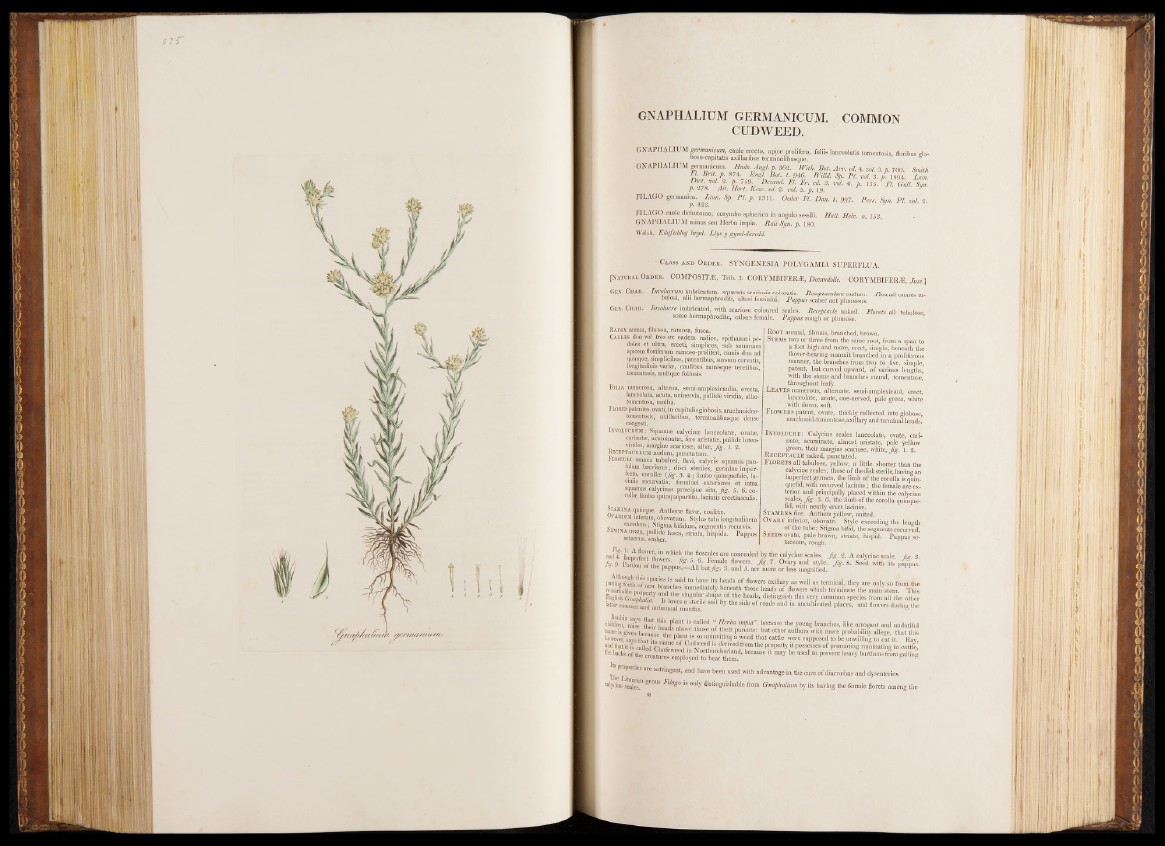
GNAPHALIUM GERMANICUM.
CUDWEED.
COMMON
GNAPHALIUM getmanicum, mule erecto, apice proliféra, foliis lanceolatis tomentosis, Aoribus do-
boso-capitatis axillaribus terminalibusque. 6
GNAPHALIUM mrmanicum. B u is. Angl. p. 362. With. Bat. Arr. ed. 4. ml. 3. 9. 700 Smith
m f ë m P- H B I Bot. a w Willi. Sp. PI. ml. S .p . 1,894. Lam.
Diet. vol. 2. ». t 59- Decand. FI. Fr. ed. 3. ml. 4. ». ] 35. Fl Gall Sun
P' 278. Ait. Dort. Kero. ed. 2. ml. 5. p. 19. S ‘
FILAGQ germanica■ ^ i n n . Sp. PI. p . 1311. Oeder Fl. Dan. t. 997. Pers. Syn. PI. m l 2.
FILÂGO caule dichotomo, corymbo sphærico in angulo sessili. Hall. Hclv. n. 153.
GNAPHALIUM minus seu Herba impia. Rail Syn. p . 180.
Welsh. Edafeddog Iwyd. I ly s y gynd-daredd.
Class and Order. SYNGENESIA POLYGAMIA SUPERFLUA.
[Natural Order. COMPOSITÆ, Trib. 3. CORYMBIFERÆ, Decandolle. CORYMBIFERÆ, Juss.]
Gen. Char. Involucrum imbricatum, squamis scariosis coloratis. Receptaculum nudum. Flosculi omnes tu-
bulosi, alu hermaphroditi, alten feminini. Pappus scaber aut pi umosus.
Gen. Char. Involucre imbricated, with scariose coloured scales. Receptacle naked. Florets all tubulose
some hermaphrodite, others female; Pappus rough or plumose.
Radix annua, fibrosa, ramosa, fusca.
Caules duo vel très ex eadem radice, spithamæi pédales
et ultra, erecti, simplices, sub summam
apicem floriferam ramoso-proliferi, ramis duo ad
quinque, simplicibus, patentibus, sursum curvatis,
longitudinis variæ, caulibus ramisque teretibus,
tomentosis, undique foliosis.
Folia numerbsa, alterna, semi-amplexicaulia, erecta,
lanceolata, acuta, uninervia, pallide viridia, albo-
tomentosa, mollia.
Flores patentes, ovati, in capitulisglobosis, arachnoideo-
tomentosis, axillaribus, terminalibusque dense
Root annual, fibrous, branched, brown.
Stems two or three from the same root, from a span to
a foot high and more, erect, simple, beneath the'
flower-bearing summit branched in a proliferous
manner, the branches from two to five, simple,
patent, but curved upward, of various lengths,
with the stems and branches round, tomentose,
throughout leafy.
Leaves numerous, alternate, semi-amplexicaul, erect,
lanceolate, acute, one-nerved, pale green, white
with down, soft.
F lowers patent, ovate, thickly collected into globose,
arachnoid-tomentose, axillary and terminal heads.
Involuc&um: Squamaj calycin® lanceolate, ovate,
carinate, acuminate, fere aristate, pallide luteo-
virides, margine scariosaj, albas, fig. 1.2.
Receptaculum nudum, punctatum.
Flosculi omnes tubulosi, flavi, calyci's squamis pau-
lulum breviores; disci steriles, germine imper-
fecto, corollas (fig. 3 . 4 .j limbo quinquefido, la-
ciuiis recurvatis; feeminei exteriores et intra
squamas calycinas prascipue sita, fig. 5. 6. corollas
limbo quinquepartito, laciniis erectiusculis.
Stamina quinque. Antheræ flavæ, coalite.
uvaeiom inferum, obovatum. Stylus tubi longitudiner
excedens; Stigma bifidum, segmentis recurvis.
öemina ovata, pallide fusca, striata, hispida. Pappu
setaceus, scaber.
I nvolucre: Calycine scales lanceolate, ovate, carinate,
acuminate, almost aristate, pale yellow
green, their margins scariose, white, fig . 1 . 2.
Receptacle, naked, punctated.
Florets all tubulose, yellow, a little shorter than the
calycine scales; those of the disk sterile, having an
imperfect germen, the limb of the corolla is quin-
quefid, with recurved lacinias; the female are exterior
and principally placed within the calycine
scales, fig . 5. 6. the limb of the corolla quinque-
fid, with nearly erect lacinife.
Stamens five. Anthers yellow, united.
Ovary inferior, obovate. Style exceeding the length
of the tube; Stigma bifid; the segments recurved.
Seeds ovate, pale brown, striate, hispid. Pappus setaceous,
rough.
and 4 TmiW'f'I6« " ^ h the floscules are concealed by the calycine scales, fig . 2. A calycine scale fia 3
^ with
C la E p r o p c r t ; uXllr !mm,ediaJely b7 “f t h o s X S f o ? f l o ^
children, raise I W m B S ° f led I ! » ,mP‘a the branches, like arrogant and undutiful
»nine is,given becauL th . n f T ? f !b“ r paren? but olher authors with more probability allege, that this
however, says that S n l e ^ f r ’? 0 ? " Clttle 'Tere suPPosed 10 be unwilling to S t it. Hay,
««1 thatit is called r E of, 9 udJ eed 18 derived from the property it possesses of promoting ruminating in cattle,
bKk‘ of the creaturarêmplôyed '? o t a i t h l ’ “ be *** 10 Prevent ^ burthen8 * “"1 galling
Propertl* “ O »stringent, and have been used with advantage in the cure of diaircehas and dysenteries,
oulycine scales. ^CnUa ^ a g o is only distinguishable from Gnaphalium by its having the female florets among the